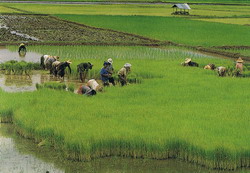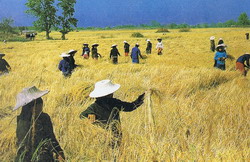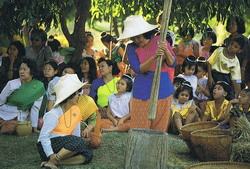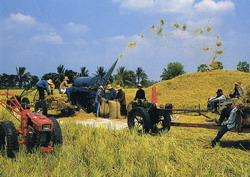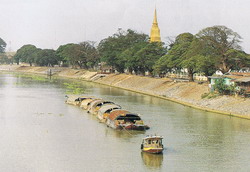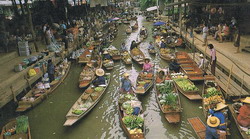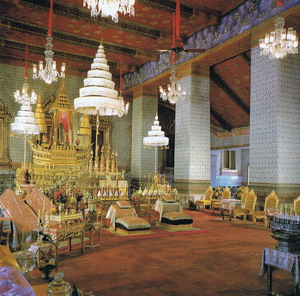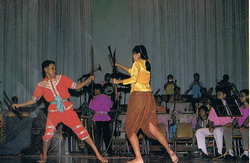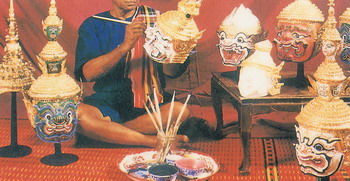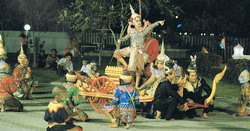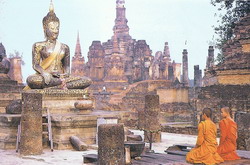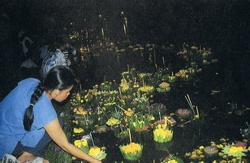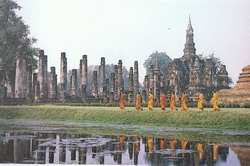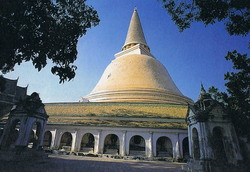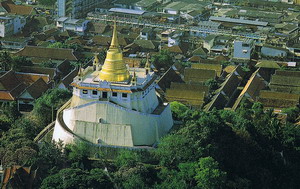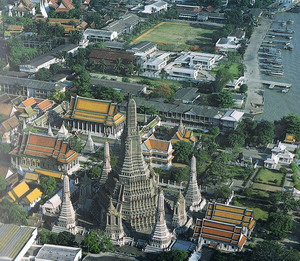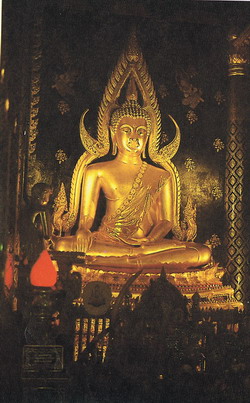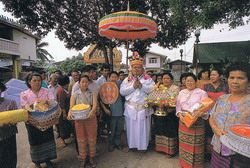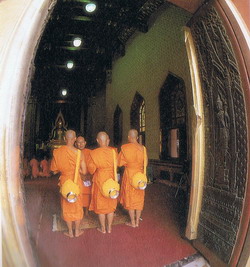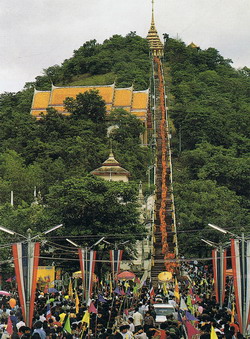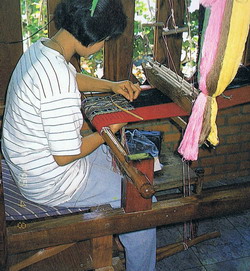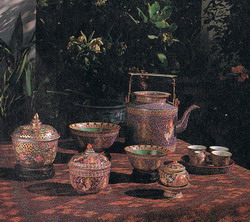
Search
 Custom Search
Custom Search
Cultural Landscape of the Central Region of Thailand Geographical Setting The Central region compises 22 provinces of Sukhothai, Kamphaeng Phet, Phichit, Phetchabun, Nakhon Sawan, Uthai Thani, Chainat, Sing Buri, Ang Thong, Sara Buri, Suphan Buri, Phra Nakhon Si Ayutthaya, Pathum Thani, Nonthaburi, Bangkok, Nakhon Nayok, Nakhon Prathom, Samut Prakan, Samut Sakhon and Samut SongKhram. It covers a land area of 91,795 square kilometers or 17,89% of the total land area of the country. Most of the central region is made up of alluvial land except for the outer circumference which is mountainous or hilly resulting from the process of erosion and sedimentation.
The flatland in the central region can be divided into two parts: - Upper floatland of Ping, Wang, Yom and Nan Rivers basin - Lower flatland of Chao Phraya River basin which is often inundated yearly due to the marrow passage at Bang Sai in Phra Nakhon Si Ayutthaya Province, together with abundant rainwater from May to October and rising seawater. Goegraphical Conditions and Occupations of the Central Thais Wet rice agriculture has been a major source of affluence for the central region that it is normally called "the rice bowl of the country". Its fine alluvial soil is rich in nutrients and retain humidity very well.
There are several methods of growing rice depend on the reographical landscapes and the abundance of water. Central Thail use rice-broadcasting methods on high grounds, while rice-transplanting is used in the water-contrlled area. However, in deep pool or old ditches with over a meter of inundated water, the wet-rice method is appropriate. In water-controlled area where labor is scarce, broadcating rice in plowed mire proves to be productive and rice terrace is a successful method in the sloped areas.
Rice farming is still the most important occupation since rice is not only the Thais' staple food, but it is also a major export product. His Majesty the King has devoted great efforts to assist the farmers in their rice production; for example, setting up experimental rice plots at Dusit Palace to select more productive types of rice for each geographical area, and to distribute rice seeds to farmers. His Majesty also initiated artificial rain to alleviate the drought problem in certain areas and introduced irrigation systems and to develop agricultural land and water sources. During the dry season, central region farmers grow vegetables, corns and peas for additional income. Second rice crops are also possible in well-irrigated areas or inundated river basin.
When water recedes, farmers can go fishin and shrimp netting. In addition, aquaculture can be found in natural basins throughout central region. In their leisure, farmers produce handicrafts, weaving cloth, shaping iron, making wickerwork and carving wood. Apart from rice planting, the Central Thais also grow fruits, vegetables, spices, decorating plants and flowers. Those who live along the shore engage in fisheries and develop aquaculture such as shrimp and shellfish farming. In addition to selling fresh marine produce, they preserve it in the form of dried or salted fish, shrimp and crab. Domestic animals are also raised for protein foods, such as chickens, ducks, pigs and cows.
Traditionally, farmers taken their surplus produce to the nearby market or community have these who lived by the canal or river would load their boats and form a "floatin market". Some central Tahis engage in petty trade. The Chinese Thais, however, are accomplished traders. They set up shops in local communities. Several Chinese settlements have become prosperous trading centers such as the China Town in the Sam Peng and Yaowaraj areas of Bangkok. Agricultural produce is transformed into consumer food and goods through household industry or even medium or large-scale industry such as the production of flour, sugar, instant food, animal food, furniture, clothers and accessories, leather, paper, metalware, plastic etc. Industrial expansion has resulted in a large-scale migration of agricultural labor into the cities.
Several problems have unavoidably stemmed from industrial growth and population migration, for instance, the lack of agricultural labor in the rural areas, the increase in slum areas as well as other socio-economic and environmental problems. On the other hand, construction of basic infrastructure coupled with a strong atricultural base has raised Thailand's purchasing power. As a result, foreign investment has increased tremendously in the last decade. Nevertheless, this economic progress has ostensibly made a great impact on lifestyle, culture and environment in the central region. His Majesty the King has been attentive to environmental and other crucial problems such as floods, traffic congestion, and political unrest and has played a crucial role in implementing several projects to alleviate problems.
In sum, the economic base of the central region has expanded from agriculture, handicrafts and petty trading to full-scale industries. Therefore, occupations become more varied and are also more dependent on foreign invertment and technology. Ethnic Groups and Settlements The entire central region is suitable for human settlement because of its fertile enviroment, numorous waterways and seashone access. Archaeological findings to the fact that the cetral has witnessed human settlements since the prehistory period. Traces of ancient civilizations have also benn discovered in the region. Evidently these civilizations adopted certain cultural elements from one another, including from foreign sources such as Indai, China, Khmer and Mon. Due to the climate and geographical setting which facilitate agriculture, the central region has become the center of settlement, political administration, economic activities and transportation. Despire the fact that the population density is relatively high, the central region has remained a peaceful, multi-*ethnic society. Cultural Factors For over 700 years, the coutry's capital cities have always been located in the central region, making it not only the center of numerous activities, but also the ceter of Buddhism, art and ethnic interaction. Exquisite art and cultural works have been inspired, created and dedicated to the Buddhist religion as well as the monarchy which is generally loved and highly revered. - Material Culture Houses
The forms and materials of a central Thailand house are well-adapted to the local climate and environment: hot weather, abundant rain, numerous waterways and frequently-flooded basins. A common house is built with a bamboo or wooden structure, fastened together with rattan strips. The floor is raised high above regular flood line to deter poisonous animals such as snakes and centipedes. The breeze which flows beneath the house keeps the lower area dry. After the flood recedes, the downstairs area is used as a living and resting area, as well as for storage and animal shelter. Roofs are thatched with palm or grass leaves. Where there are numerous waterways, houses are built along rivers or canals. Some are houseboats which are generally double detached houses built over bamboo float or log float parallel to the waterway. The outer part of the house is used as a vending area or an exit to the water white the inner part is for sleeping and the rear is a cooking area.
The well-to-do live in raised, wood-planked house. House structures are constructed so that they can be slipped together and transfixed with wood pins. The walls and floors and floors are made with wood planks. The base of the house is wide than the top part and the posts are crected so that they lean towards the inside. As a result, they carry much of the weight from the roof structure and stand securely. The house floor is on a higher level than porch floor which is proportionate to the lower roof that protects the house from the rain. The roof is A-shaped and covered with thatch, wood or terra cotta tiles, it slopes up high so that rainwater is drained quickly and hot air is lifted up and vented out. Initially, the house may comprise only of a bedroom a kitchen. After a family has additional children or after the children grow up and get married, more houses or rooms added within the compound to suit the size of the extended family; for example, there may be extra bedrooms, a living room for family use, for guests, or for holding gatherings. Mask-making craftsman Wealthy people with many servants may have a large compound of houses with rooms as stated above. In addition, they may have a parlour for administrative purposes, a chapel where for Buddha images are kept, a multi-purposed open area as well as an area for hanging dove cages. The outer porch is used for hobby activities such as growing potted plants and miniature trees, raising pet fish, making handcrafts, etc.
The styles of houses in the central region have changed significantly due to urbanization, change in lifestyle, and new construction technology. Shop houses, housing, apartments, condominiums, and highrise buildings have emerged in wester-style architecture. Since the central region has been the political center for over 700 years, there are numerous places of significant instance, in the ancient capitals of Sukhothai, Ayutthaya, Lop Buri, and Thonburi. Unfortunately, some of these places are in a dilapidated condition. The layout of the Grand Palace in Bangkok is similar to that of the royal palaces in the ancient capitals. Located in the heart of the town it is secured with layers of moats, palace walls, and gates. The buildings, resplendent in majestic beauty, reflect the nation's long stability and affluence.
Within the Grand Palace, there is a cluster of buildings with the King's private quarters and throne halls for administrative purpose and for holding rituals. Other throne halls were subsequently added inside and outside the royal complex. The most striking feature of these palace is the multi-layered roofs intricately decorated with gold. The use of symbols such as Garuda and Naga, or Vishnu mounting on Garuda signifies the King's great honor since he is revered as a reincarnated god who will eliminate evil in the kingdom. After Thailand had adopted western culture, the artistic and architectural styles of royal palaces gradually altered. The use of foreign forms, techniques, materials and art stlyle resulted in a mixture of European art with traditional Thai art or the replacement of traditional Thai art altogether. Religious Places
Since the old days, Thai people have aspired to establish Buddhism as the core of Thai culture and a pillar of society, hence it is customary to build a pagoda containing relics of the Lord Buddha at the heart of each principal city. Numerous stupa and pagodas were buil for various other purposes and in a variety of shape. As the societies evolved and became more secured and communities expanded, the Thais also built temples within their communities to accumulate merit for their next life. There are several structures in a temple such as the ordination hall (The Ubosoth), the Vihara, the hall which houses the Tripitaka and other scriptures, all-purposed pavillions, drum towers, etc. |
Click Here!
|
In the Ayutthaya period, Thai men wore loincloths and they wrapped their long hair in a turban. The women wore loincloths and chest cloths and tucked their long hair into a bun decorating it with fresh flowers. Footware was not used.
Since the reign of King Rama IV, the style of Thai dress has been influenced by the West especially in the capital. Nowadays, urban Thais have adopt wester-style dressing as it is deemed to be more convenient and versatile. Culinary Habits Rice and fish have traditionally been the staple for the Central Thais. Foreign food cultures such as the use of a variety of meats and spices has also been adopted. The four major categories of main dishes are —chilly dip eaten with fresh vegetables, currys, sour soup and spicy salad, plain soup and sautéed vegetables. There are several types of desserts such as those mixed with coconut milk and sugar steamed, baked or preserved. Handicraft Production
Farmers spend their leisure time to produce handicrafts for everyday use ; for example, wickerwork hats, baskets, fish traps, fans, mats and mobiles. These are made from local materials such as bamboo and rattan. Their Majesties the King and Queen have also encouraged farmers and villagers to produce a variety of fine handicrafts to augment their incomes as well as to utilize or recycle materials such as the water hyacinths which obstructed the water ways in the region. Glazed and unglazed pottery are also produced and modern techniques have been introduced so that the quality is vastly improved. Artistic Creation Temple decoration is an important art creation because of the Thais deep dedication to Buddhism. Artists also consider it as a form of a merit making to create a beautiful piece of work for the temple.
After constructing pagodas temples, the Thais cast large images, to be placed as the principal image of a temple. The Buddha images are cast in different positions or attitudes which signify significant in the life of the Lord Buddha ; for example, the attitude meditation signifies the period of persevering to attain enlightenment. Apart from Buddha images the Thais also decorate stupa, pagoda, ubosoth and vihara with carving, casting, sculpture, etc. Mural painting is not only a decoration, but also a means to educate the laypeople about Buddhism and the Dhamma or the teacings of Lord Buddha. Leisure and Recreation The children enjoy a numerous array of games and recreational activities while the adults have folk songs which they sing during work and leisure. Many musical instrments are made from are made from local materials such as bamboo, wood, coconut shelt, leather, etc. Musician ensembles are performed during rituals or to accompany performances. Villagers have many forms of entertainment during festive occasions such as boxing, fencing, folk play and bald-headed fighting. In the capital, mask dances and grand shadow puppets shows are performed at various royal festivals as a form of entertainment and as a training practice for royal soldiers. Royal plays were performed in the palace and were more refined than folk plays. These dances and performances function as entertainment as well as education and cultural purposes especially in non-literate society. Abstract Culture
In the past, the King reigned supreme with absolute power. The elites congregated and around their ruler in the capital. As a result, new tradition emerged which could be distinguished from the "commoners" or "folk traditions". "Elite traditions" or "court traditions" exalted the King's status by adopting the concepts and customers from Brahmin tradition provalent in India, Khmer and Mon societies. Belief System Since the old days, the central Thais have been animists who believe in various spirits thay dwell in nature. They also believe that if the spirits are treated with appropriate respect and provided gifts and propitiatory rituals, they will provide protection and be a source of happiness, success and prosperity to human beings. On the contrary, if the spirits are ignored, then they will cause suffering and even disaster. This common belief contributes to hamonious in human society since people would be afraid of breaching social norms for fear that they may be punished punished by the spirits. Central Thais also believe in dream predictions, omens, amulets, healing magic, etc. These beliefs have become somewhat less popular due to the influence of scientiric reasoning. Yet certain practices which yield a positive psychological effect and strengthen human relations are still common. Customs and Traditions
Central Thai customs and traditions are influenced by traditional beliefs, Buddhist and Brahmin traditions. Folk customs and traditions are practiced on the rural area among villagers whereas court customs and traditions are practiced in a larger scale and are more complicated. Various rituals are held for such purposes as to obtain occupational success, happiness and safety as well as on religious occasions and festivals. Rice-farming has always been a major occupation of the central Thais. Because the success of this occupation is dependent upon environmental conditions, farmers perform age-old ritual to ask for a good harvest from the supernatural forces such as to asd for rain or to celebrate a harvest, etc. The Thai Kings have also recognized the importance of rice farming and presided over several royal rituals to encourage farmers in their endeavors.
Human beings live in fear of illness, suffering, spiritual possession and death, hence they behave themselves according to traditional beliefs to ensure good bealth, happiness and safety. Many other rituals are also held according to traditional beliefs such as birth ritual, ordination, house warming and death ritual. The royal family, and the nobility also have similar rituals, but evidently they are more elaborate.
Other common rituals are religious rituals which take place on significant Buddhist festivals, the Songkran ritual to celebrate the traditional Thai new year, the Loi Krathong is the lantern festival in November to pay respects to and ask for forgiveness from the rivers. Some of the rituals have been adapted, transformed or even lost. But those which have remained still serve the traditional purposes and reflect the unity in the central Thai society. Language and Literature Thai people are proud of their language and writing system since they are an internal part of the culture and a medium to pass on cultural heritage. Language is also reguarded as a "miirror" of cultural elements such as social systems, lifestyles, wordviews, beliefs, social values, etc. For example, the old saying "fish in the water rice in the fields" and "eat rice and fish" reflect the environmental abundance, economic subsistence and cultural lifestyle of the central Thais whose staple is rice and fish.
The combination of language and ideas or imagination often evolves into oral and written literature. Literature serves distinctive purposes and it is expressed in various forms. It plays a significant role in human life, from childhood lullabies and games to folktales, work songs, boat songs, and even religious tales and Buddhist sermons. The Kings, royal family, and the nobility have a more refined literature. Many Thai monarchs were the oneselves patrons of poets and artists, and instill strong ethics and loyalty among those under his reign. A good deal of literature has religious themes and didactic overtones with the aim of creating a peaceful society. Food and Medicines From ancient times, the Thai people have derived medicines from natural sources to treat their ailments. These natural medicines are divided into three types ; herbal medicines such as the vine of the Tinospora crispa, Belsonia campestris, the roots of solnum incanum, Zingiber cassumunar, cloves, the fruit of the Terminalia, the skin of Pentace burmanica Kurz, Fimbristylis barbata etc. ; traditional medicines derived from animals such as rhinoceros horn, porcupine needles, gall bladder of snakes, honey, bat excrements etc.; and other types of folk medicines from minerals such as camphor, alum, red lime, table salt, talc, etc.
Each type of folk remedy usually comprises serveral kinds of medicinal elements which have been prepared by several methods like crushing or pounding the ingredients and mixing them with honey or rolling them into small balls, others are pulverized and mixed with water to be drunk or applied directly to the skin, while some are boiled in clay pots and are called "ya tom". Another type is soaked in water boiled in galingale roots or liquor and are called "ya dong". Thai folk remedies and herbal medicines are still being used despire the fact that modern medicines is now widely practiced. Modern ways have been explored so as to make these folk ways more convenient to use practice.
Since Thailand's capitals have always been situated in the central region, the region is seen as an archetype for other regions and a representative of Thailand in various aspects including the cultural dimension which makes the region somewhat emblematic of a national identity. Central Thai were also the first groups of people to establish, contact with outside world and adopted foreign culture so that a new culture gradually permeated to the other regions of the country. Thai culture, as such, can be characterized as having been, and being, dynamic.
|
